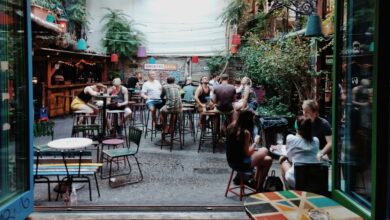Adebola Adeshina: ‘If I wouldn’t eat it, why would I serve it?’
Adebola Adeshina is the chef patron of two restaurants near Peterborough, The Chubby Castor and The Yard. In order to serve more healthy foods and become more mindful of the environment, Adeshina decided to start growing fruits and vegetables in the restaurant’s garden. He told Catering Today how he manages to keep this sustainability ethic in his kitchen.

Register to get 1 free article
Reveal the article below by registering for our email newsletter.
Want unlimited access? View Plans
Already have an account? Sign in
- Can you tell me about your journey as chef patron at Chubby Castor?
So it all started happening in 2017 when I was looking for a site, my agent called me and said he had a place for me in a village called Castor. So I went there and met the Fitzwilliams and we bought into a deal: we took the building over, we had to revamp it all for a new kitchen, a new floor and made sure it was what we wanted and what the customers wanted.
- The restaurant has a strong sustainability ethic. Can you tell me more about this? How did it start?
As the restaurant was trying to progress and going forward, we realised we had this big space at the back and I started thinking, what can I do with this empty space? And I thought, why don’t we start growing our own vegetables? So I called some local gardeners, who live in the village, and they said it was possible to do it although it might not take off straight away, because obviously some vegetables that you plant are ready to be harvested later in the year. For example, when we first planted rhubarb we had to wait a whole year before harvesting. So there’s quite a lot of work in growing your own food but it just tastes so much better and is much more nutritious than buying average vegetables.
- When you decided to grow fruits and vegetables in your garden, what type of considerations did you have to make before starting to do so?
First of all, obviously, everything is seasonal so the menu has to change accordingly. You have to think for example that the vegetables that you plant in April are not going to be ready before July and so on. And then you have to keep in mind that problems can arise. For instance, the first year we grew our strawberries, the caterpillars ate pretty much all of them. But it’s okay, it was a learning process and you have to understand the soil that you have as well. Another thing to keep in mind is that you need to have a schedule and plant seeds in advance. For example, we plant our potatoes at a certain time of the year so that when winter comes we already have enough, because during winter everything gets frosted and it’s really hard to grow anything.
- More or less how many vegetables would you say that you grow in the garden?
We have different types of potatoes, strawberries, pumpkins, butternut, carrots, rhubarb, cabbage, courgette, courgette flowers, onions and spring onions. And then some herbs such as mint, basil and chilli.
- In your opinion, is it easier or harder to grow vegetables for a restaurant instead of relying on food suppliers?
To be honest with you, cost-wise it is expensive to grow your own food. I think it’s an investment, also because you have to wait at least a couple of years to really see the benefit of it. So initially it is costly but then in the long term you’re not paying for it anymore. We do still buy certain things from local suppliers because we can’t grow everything but we still manage to grow 70% of it and I think that’s a win both for us and the customers, who can be sure to be eating healthy foods.
- Apart from growing fruits and vegetables in the garden, do you do anything different in your kitchen to keep being sustainable?
Well, we don’t use gas to cook, it’s all electric. And I think while it is more sustainable for the environment, it’s also easier for us chefs to use.
Apart from that, we really try to cook as healthy as possible for our customers. We fry very little things, we try to reduce our usage of butter and our desserts have cut sugar by 25%. I’m a big believer in using natural organic products and what we always say in the kitchen is: if I wouldn’t eat it because it’s not good for the body, why would I give it to my customers? And I think customers notice it and appreciate it.
- What are the customers’ reactions when they find out that what they’re eating is actually grown back in the garden?
They love it, they really do love it and they taste the difference. And they do tell us to continue doing it. And I think part of it is also because we have a dining area in the garden as well where they can actually see the chef going around and picking the vegetables, so they know that what they’re going to eat was sourced right in front of them.
- What advice would you give to another restaurant that wants to start becoming more eco friendly?
I think revise the ingredients you really need in the kitchen, I believe that’s the number one advice I would give. So for example start asking yourself do I need to put so much butter in cooking this steak? Does the meat really need that much butter? No, it’s just a waste for the environment on top of being unhealthy.
Then of course I suggest turning appliances off when you’re not using them. Be more conscious around what you’re using; if you don’t need your gas, don’t leave it on all day. And lastly, obviously I would 100% recommend starting to grow your vegetables if you can. You can start with something little, like herbs, and then before you know you see that it’s worth it.







